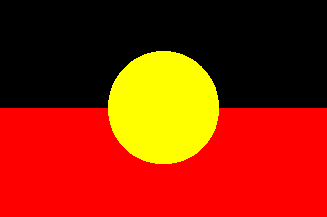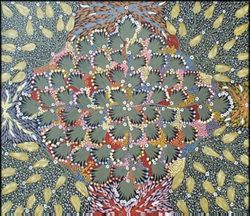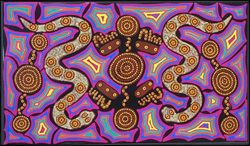

It is thought that Aborigines have been living in the continent for the last 50,000 years, originally migrating from Indonesia. The oldest skeleton found in Australia was at Lake Mungo in south-west New South Wales, believed to be 38,000 years old and bears traces of ceremonial ochre.
Unlike most races, Aborigines relied on a form of controlled burning of vegetation known as "fire stick farming". They did not develop the sense of land ownership, though children where taught that they belonged to the land and must respect tribal boundaries. There were some sites that were designated sacred sites in association of Dream time, the time when earth was formed and cycles of life and nature where initiated.
Aborigine's sing and dance to tell of the legends of powerful spirits who created the land and people during the Dream time. There is no known written Aboriginal language and most of the 600 tribes spoke different dialects, the rarely met except on ceremonial occasions.
To tell stories Aboriginal people painted and carved into rock, they can be seen to these days. They have been preserved and can be viewed at rock galleries in Kakadu National Park and other parts of Northern Australia. There are Aboriginal artists that sell there work to the world. Aboriginal tribal art has many forms of expression. The principal ones are paintings, carvings, statuary, and basketry. The northern tribes traditionally paint on bark, although archivial paper is becoming popular. The desert tribes customarily paint on canvas even though older are done on art board. Carvings and Statuary and produced by The Northern and Island tribes, basketry is done in both desert and Northern settlements.
Many bad things have happened to the Aborigine's and Torres Strait Islanders since white people came to Australia and make it it's own. In 1951 an official assimilation policy to eliminate any sense of a separate Aboriginal identity was implemented by the government. All the Aboriginal peoples territory was occupied, their rights of self-determination and their human rights were violated. It was not till 1972 that it was recognized that there was previous ownership. Like most people of dark skin the were prejudice against and are still to this day.
These days aboriginal people live either in cities and towns or in isolated settlements near tribal lands. Few continue their nomadic ways.
In recent years, white Australians have become more sensitive to the plight of the aborigines, resulting in increased health and educational services, greater recogination of Aboriginal land rights.
There are more than 200 Australian Indigenous languages, most of which have been destroyed; all the others are endangered. To find about the languages that wherespoken go to this site Aboriginal Languages of Australia, Aboriginal and Torres Strait Islander Languages.
Below is some Aboriginal art. Didjeridoo's that are painted by local artists. To find out more about their art of maybe buy some of the artwork go to aboriginal australia.com
 ...................................
...................................
Bush
Banana
Grandmothers & Grandaughters
by Rosie Daniels
by Rachel Bray
Didjeridoo's